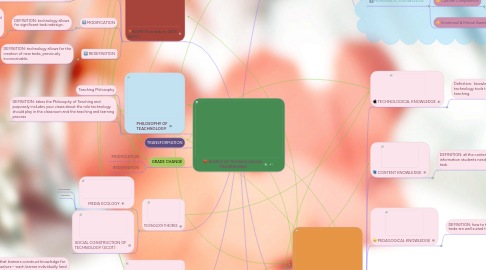
1. SAMR (Puentedura, 2006 &2011)
1.1. SUBSTITUTION
1.1.1. DEFINITION: technology acts as a direct tool substitution with no functional change
1.1.1.1. EXAMPLE OF SUBSTITUTION: when computer technology is used to do the same task as was done before. NO significant change in final grades at this level.
1.2. AUGMENTATION
1.2.1. DEFINITION: technology acts as a direct tool substitute with functional improvement.
1.2.1.1. EXAMPLE OF AUGMENTATION: computer technology offers an effective tool to perform common tasks such as using google docs to receive immediate feedback via the sharing button. No significant change in final grades at this level.
1.3. MODIFICATION
1.3.1. DEFINITION: technology allows for significant task redesign.
1.3.1.1. EXAMPLE OF MODIFICATION: enhance the traditional classroom environment and transform it by using technology. Students are asked to write an essay and record it with original music then give each other feedback. There is half of a grade difference in final grade activities.
1.4. REDEFINITION
1.4.1. DEFINITION: technology allows for the creation of new tasks, previously inconceivable.
1.4.1.1. EXAMPLE OF REDEFINITION: computer technology allows for new tasks that were not previously possible. Create a documentary video that answers questions related to important concepts. It allows communication to occur and is student generated. One full grade difference in final grades.
2. PHILOSOPHY OF TEACHNOLOGY
2.1. Teaching Philosophy
2.2. DEFINITION: takes the Philosophy of Teaching and purposely includes your views about the role technology should play in the classroom and the teaching and learning process
3. TRANSFORMATION
4. GRADE CHANGE
4.1. MODIFICATION
4.2. REDEFINITION
5. TECHNOLOGY THEORIES
5.1. MEDIA ECOLOGY
5.1.1. Neil Postman
5.1.2. Definition:
5.2. SOCIAL CONSTRUCTION OF TECHNOLOGY (SCOT)
6. LEARNING THEORIES
6.1. CONSTRUCTIVISM
6.1.1. idea that learners construct knowledge for themselves---each learner individually (and socially) constructs meaning---as he or she learns
6.1.2. Constructivist Learning Theory:http://www.exploratorium.edu/ifi/resources/constructivistlearning.html
6.2. COGNITIVISM
7. 21ST CENTURY LEARNING
7.1. FOUNDATIONAL KNOWLEDGE
7.1.1. Core Content
7.1.1.1. DEFINITION: applying mathematical ways of thinking to solve everyday problems or applying scientific ways to natural world.
7.1.2. Digital & Information Lieracy
7.1.2.1. DEFINITION: ability to effectively and thoughtfully evaluate, navigate and construct information using a range of digital technologies.
7.1.3. Cross-disciplinary
7.1.3.1. DEFINITION: integrate and synthesize information across fields such as the application of knowledge to new contexts.
7.2. META KNOWLEDGE
7.2.1. Problem Solving & Critical Thinking
7.2.1.1. DEFINITION: ability to interpret information and make informed decisions.
7.2.2. Communication & collaboration
7.2.2.1. DEFINITION: ability to articulate oneself through all media of communication while being an active and respectful listener.
7.2.3. Creativity
7.2.3.1. DEFINITION: apply wide range of knowledge and skills to the generation of novel and worthwhile products and ability to evaluate, elaborate and refine ideas.
7.3. HUMANISTIC KNOWLEDGE
7.3.1. Life & Job Skills
7.3.1.1. DEFINITION:ability to manage and organize one's effors, and coordinate relevant important information.
7.3.2. Cultural Competence
7.3.2.1. DEFINITION: effective communication, collaboration, and appreciation of ideas and emotions of all types of individuals.
7.3.3. Emotional & Ethical Awareness
7.3.3.1. DEFINITION: ability to intuit the feelings of others, have deep understanding of human emotions and interactions.
8. TPACK
8.1. TECHNOLOGICAL KNOWLEDGE
8.1.1. Definition: knowledge of the different types of technology tools that can be integrated into teaching.
8.1.1.1. ability to use operating systems.
8.1.1.2. knowledge and skills required to operate particular technologies.
8.1.1.3. how to install and remove devices, software programs and documents.
8.1.1.4. ability to learn and adpt to new technologies
8.1.1.5. specific hardware and software skills.
8.2. CONTENT KNOWLEDGE
8.2.1. DEFINITION: all the content information students need to complete task.
8.2.1.1. subject matter, central facts, theories and procedures within a given field.
8.2.1.2. explanatory frameworks that organize and connect ideas.
8.2.1.3. crules of evidence and proof and the nature of knowledge and inquiry in different fields.
8.3. PEDAGOGICAL KNOWLEDGE
8.3.1. DEFINITION: how to teach and if tasks are well suited to learners.
8.3.1.1. student thinking and learning.
8.3.1.2. processes and practices or methods of teaching and learning.
8.3.1.3. classroom management, and lesson plan development and implementation
8.3.1.4. strategies for evaluating student understanding
8.3.1.5. how students construct knowledge, acquire skills and develop habits of mind.
8.4. TECHNOLOGICAL CONTENT KNOWLEDGE
8.4.1. DEFINITION: how technology can be used to teach or conceptualize content.
8.4.1.1. knowledge about the manner in which technology and content are reciprocally related.
8.4.1.2. manner in which subject matter cna be changed by technology
8.4.1.3. recognize when a software program merely emulatese what is done when learning traditionally.
8.4.1.4. recognize when a technology changes the nature of learning itself.
8.5. TECHNOLOGICAL PEDAGOGICAL KNOWLEDGE
8.5.1. DEFINITION: affordances and constraints of technology as an enabler of teaching purposes.
8.5.1.1. knowledge of the existence, components, and capabilities of technologies
8.5.1.2. knowing how teaching might change due to particular technologies
8.5.1.3. the ability to choose a tool based on its fisness
8.5.1.4. strategies for using tool's affordances and the ability to apply pedagogical strategies for use of technologies
8.6. CONTENT PEDAGOGICAL KNOWLEDGE
8.6.1. DEFINITION: how teaching is dependant on content area knowledge. Interplay between how to teach and a specific subject area
8.6.1.1. manner in which subject matter is transformed for teaching
8.6.1.2. ways of representing and formulating the subject that make it comprehensible to others
8.6.1.3. how topics area adapted to the diverse interests and abilities of learners.
8.6.1.4. knowing what teaching approaches fit the content
